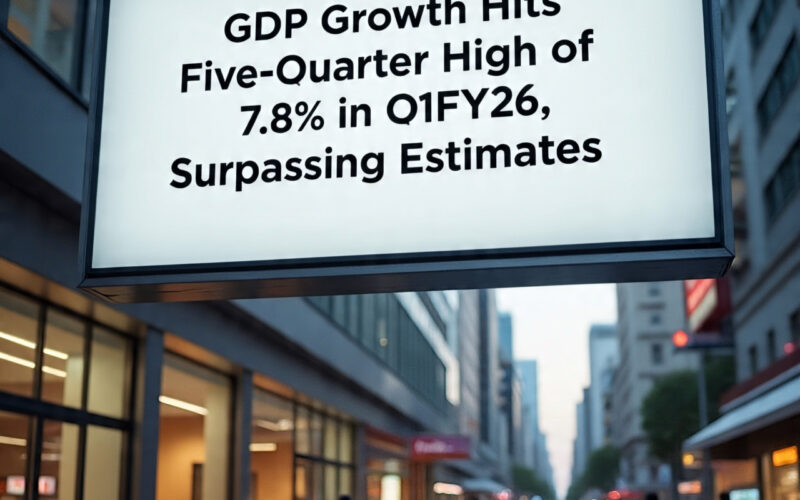#IndiaGDP #EconomicGrowth #Q1FY26 #IndianEconomy #GDPData #ServicesSector #Manufacturing #RuralDemand #ConsumptionGrowth #Investment #RBIPolicy #GlobalEconomy
Services sector leads growth; consumption and rural economy provide strong support
New Delhi– India’s economic growth surged to a five-quarter high in the first quarter of FY26, clocking an impressive 7.8 percent GDP growth, beating both official and market expectations. The latest numbers not only outperformed the Reserve Bank of India’s (RBI) projection of 6.5 percent but also exceeded the Moneycontrol poll median forecast of 6.6 percent. This marks a sharp acceleration from 6.5 percent growth in Q1FY25 and an uptick from 7.4 percent recorded in the last quarter (Q4FY25).
Economists and policy analysts say that the stronger-than-expected growth print reinforces India’s resilience at a time when the global economy faces headwinds, and geopolitical trade frictions threaten export momentum.
Services Sector Leads the Charge
The services sector was the standout performer, growing at 9.3 percent, its fastest pace in two years. Within services, government-related activities surged to a 12-quarter high of 9.8 percent, reflecting higher public expenditure and welfare-linked activities.
Other segments like financial, real estate, and professional services also posted robust growth of 9.5 percent, while trade, hotels, transport, and communication accelerated to 8.6 percent, their best performance in nearly two years. Services as a whole now contribute nearly 53 percent of India’s GDP, underscoring their dominant role in driving economic expansion.
Manufacturing Defies Expectations
Contrary to signals from muted industrial production and weak PMI data earlier in the quarter, manufacturing posted a strong 7.7 percent growth. This nearly matched the previous year’s high base of 7.6 percent, suggesting that domestic demand and supply-side efficiencies helped industries maintain momentum.
Construction activity, however, moderated, recording a growth of 7.6 percent compared to 10.8 percent in Q4FY25. Analysts attribute this slowdown partly to seasonal factors and cautious private investment, though infrastructure spending by the government remains supportive.
Agriculture and Mining Weigh Down Growth
Agriculture growth slowed sharply to 3.7 percent from 5.4 percent a quarter earlier. Economists point to uneven rainfall distribution and crop output challenges in early kharif sowing as key reasons for the moderation.
Mining and quarrying was the weakest performer, contracting 3.1 percent, its lowest in 11 quarters. Electricity output also disappointed, growing just 0.5 percent, a 19-quarter low, as the early onset of monsoon reduced demand and affected production levels.
Consumption and Rural Demand Show Strength
Private consumption, which accounts for nearly 56.7 percent of GDP, rose to a three-quarter high of 7 percent, supported by a strong rural economy. Economists say rising rural incomes, government welfare measures, and stable inflation levels have provided households with greater purchasing power.
Government consumption rebounded strongly to 7.5 percent, compared to a contraction of 1.8 percent in the previous quarter, reflecting higher public spending.
Investments (Gross Fixed Capital Formation) grew 7.8 percent, slightly moderating from earlier quarters, but the investment-to-GDP ratio climbed to a three-year high of 34.6 percent, signaling long-term capacity-building and infrastructure momentum.
External Trade: Mixed Signals
Exports of goods and services grew at 6.3 percent, lower than the 8.3 percent growth seen a year earlier, while imports rose sharply by 10.9 percent due to higher oil and commodity purchases. This widening gap reflects India’s continued dependence on external demand, even as tariff-related uncertainties with the US loom in the background.
Policy Outlook: RBI Rate Cut Hopes Dented
Economists believe the stronger-than-expected GDP print could dampen expectations of a rate cut in the October 2025 monetary policy meeting of the RBI.
“The sharper-than-expected GDP growth print, which represents an acceleration over the previous quarter, has doused any expectations that the tariff-related turmoil could prompt monetary easing in the October policy review,” said Aditi Nayar, Chief Economist at ICRA.
Nominal Growth and Inflation Impact
Nominal GDP growth stood at 8.8 percent, lower than past averages, suggesting the role of a low GDP deflator. This indicates that while real growth has been robust, price pressures have been subdued, giving policymakers some breathing room on inflation management.
Global and Domestic Confidence Boost
International agencies have taken note of India’s momentum. S&P Global Ratings recently upgraded India’s sovereign rating to BBB, projecting growth of 6.5 percent for FY26 and 6.8 percent over the next three years. Analysts say the latest GDP data strengthens confidence in India’s medium-term growth story, despite global trade tensions and commodity price fluctuations.
Madan Sabnavis, Chief Economist at Bank of Baroda, remarked:
“The economy looks poised to clock the expected 6.5 percent growth rate for FY26, notwithstanding tariff effects which may shave off 0.2–0.4 percent. The low price deflator effect has also helped in boosting real growth.”
The Road Ahead
Looking forward, private consumption is expected to remain strong, driven by income tax relief, lower interest rates from earlier policy easing, and healthy agricultural prospects. However, economists caution that discretionary spending may temporarily slow in Q2FY26 until tax cuts take effect during the festive season.
At the same time, global uncertainties — particularly tariff disputes with the US — could affect export momentum and employment in specific industries. Yet, India’s domestic demand-driven economy, coupled with a growing services base and strong investment trends, is likely to cushion against external shocks.
With its robust first-quarter performance, India appears firmly on track to remain the fastest-growing major economy in the world, reinforcing its position as a global growth engine.
Hashtags:
#IndiaGDP #EconomicGrowth #Q1FY26 #IndianEconomy #GDPData #ServicesSector #Manufacturing #RuralDemand #ConsumptionGrowth #Investment #RBIPolicy #GlobalEconomy #SustainableGrowth #IndiaAsGrowthEngine

